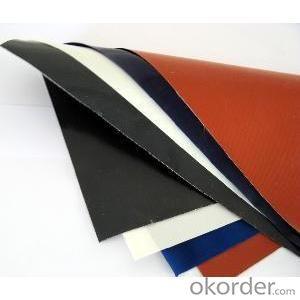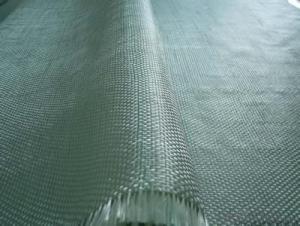Fiberglass cloth Coated with Silicon Rubber
- Loading Port:
- Shanghai
- Payment Terms:
- TT OR LC
- Min Order Qty:
- 10000 m²
- Supply Capability:
- 500000 m²/month
OKorder Service Pledge
OKorder Financial Service
You Might Also Like
Desciption:
Coated Fiberglass Fabric is made of high performance fiberglass fabric impregnated with PTFE suspension emulsion. It is a high performance, multi-use new composite material.Because of its high perforemance. It is widely used in aviation, paper, food, environmental protection, printing & dyeing, apparels, chemicals, glass, pharmaceuticals, electronics, insulation, construction ( membrane ceiling structure), grinding wheel, mechanical and so on.
Features:
1. High&low temperature endurable:
It can be used for longterm with its performance unchanged under the high temperature range from 200°C to 700°C and low temperature range from -50°C to 70°C.
2. Non-tick:
Any material is not easy to stick to it. And any stain or spot on it is easy to be cleaned away.
3. Chemical corrosion resistant:
It can resist strong acid, strong alkali, aqua regia, various organic solvents, and almost all pharmaceutical items.
4.High weatherability, anti-aging, anti-UV ray. DuPont company made an experiment and discovered that it can be placed in outside fields for thirty years with its performance unchanged.
5. High insulation property (the value of dielectric constant is only 2.6, and the value of tangent is less than 0.0025), anti-static, and the value of its surface resistance up to 1016 ohms.
6. Fire proof. Even flame cannot cause it burning.
Application of PTFE coated glass fabric:
1. Oven and microwave oven liner in Food processing.
By its high temperature resistance and nonstick characteristic, it can be made into oven liner and microwave oven liner,etc in food processing.
2. Conveyor belt: Various types of conveyor belts can be made from different thicknesses of PTFE coated glass fabric ranging from 0.06mm-1.7mm. Those with thickness of and above 0.45mm can be made into conveyor belt while those with thickness less than 0.45mm can be made into fusing machine belt, sealing belt,etc.
3. Chemical piping connection and covering material, used as vibration insulator and anti-corrosion layer; equipment protective layer, such as power plant desulfurizing unit. 4.Electrical appliances material, by its good insulation property.
5. Fireproof materials: it can be used for firewall and other fire prevention construction. 6.Demoulding materials. 7: welding blanket protecting from molten metal splash.
- Q:Can fiberglass fabric be used for making backpacks or luggage?
- Fiberglass fabric is indeed suitable for manufacturing backpacks and luggage due to its strength and durability. This fabric is renowned for its ability to create sturdy and long-lasting bags. Moreover, it is lightweight, tear-resistant, and can withstand heavy loads. The fact that fiberglass fabric is widely used in industries like aerospace and automotive further emphasizes its suitability for backpacks and luggage. Nevertheless, it is important to consider that fiberglass fabric may not be as flexible or moldable as other materials, making it better suited for rigid or structured bag designs rather than soft or collapsible styles.
- Q:Can fiberglass fabric be used for insulation in cryogenic systems?
- Yes, fiberglass fabric can be used for insulation in cryogenic systems. Fiberglass fabric is a commonly used material for insulation due to its excellent thermal properties and low thermal conductivity. It can effectively reduce heat transfer and maintain low temperatures in cryogenic systems. Additionally, fiberglass fabric is also resistant to extreme temperatures and does not degrade or lose its insulation properties in cryogenic conditions. Therefore, it is a suitable choice for insulating cryogenic systems and ensuring the efficient and safe operation of such systems.
- Q:Is fiberglass fabric suitable for use in electrical insulation tapes?
- Indeed, fiberglass fabric proves to be appropriate for implementation within electrical insulation tapes. Its remarkable electrical insulation properties and ability to endure elevated temperatures make it particularly well-suited for situations necessitating electrical insulation. Its resistance to heat, chemicals, and moisture guarantees enduring safeguarding for electrical components. Furthermore, fiberglass fabric's flexibility and ease of manipulation facilitate simple application onto diverse surfaces. All in all, fiberglass fabric stands as a dependable and efficient material choice for electrical insulation tapes.
- Q:How does fiberglass fabric handle vibration?
- Fiberglass fabric is known for its excellent performance in handling vibration. Due to its unique composition and structure, fiberglass fabric has inherent properties that make it highly resistant to vibration. One key aspect that contributes to its vibration handling capability is its high tensile strength. Fiberglass fabric is made by weaving strands of fiberglass together, creating a strong and durable material. This high tensile strength enables the fabric to withstand the forces exerted by vibrations without undergoing deformation or damage. Additionally, fiberglass fabric has a low density, which means it is lightweight and has a high strength-to-weight ratio. This characteristic allows the fabric to effectively dissipate vibrations and absorb energy, minimizing the transmission of vibrations to the surrounding environment. Furthermore, fiberglass fabric is also known for its excellent dimensional stability. It maintains its shape and structure even under dynamic conditions, which is crucial in vibration-prone applications. This stability ensures that the fabric remains intact and functional, preventing any negative effects on the overall performance of the system. Overall, fiberglass fabric is a reliable and effective material for handling vibrations. Its high tensile strength, low density, and dimensional stability make it an ideal choice for various industries and applications where vibration control is essential.
- Q:Polyurethane waterproof coating how to use, polyurethane waterproof coating what are the methods of use?
- Polyurethane waterproof coating construction process: 1., cleaning the base, 2. brushing glue, 3. details additional layer, 4., the first coating, 5., second coating, 6., third coating and clay slag.
- Q:How is fiberglass fabric used in the aerospace industry?
- The aerospace industry extensively utilizes fiberglass fabric due to its exceptional strength-to-weight ratio, thermal resistance, and electrical insulation properties. The primary application of fiberglass fabric in this industry involves producing composite materials. These materials are created by combining fiberglass fabric with resins, resulting in a lightweight and robust material that can be molded into various shapes. These composites are then used to manufacture essential parts such as fuselages, wings, and fairings, which play a crucial role in maintaining the structural integrity of aircraft and spacecraft. The incorporation of fiberglass fabric in composites allows for the production of intricate shapes while ensuring strength and durability. Furthermore, fiberglass fabric is also utilized in insulating aerospace vehicles. It acts as a thermal barrier, safeguarding the aircraft or spacecraft from extreme temperatures experienced during flight. This feature is particularly critical in space exploration, as spacecraft encounter intense heat during re-entry into the Earth's atmosphere. In addition, fiberglass fabric is employed in the electrical systems of aerospace vehicles. It possesses excellent electrical insulation properties, effectively preventing the flow of electric current and protecting against short circuits. This is of utmost importance in the aerospace industry, where electrical systems are vital for navigation, communication, and other essential functions. Overall, the use of fiberglass fabric in the aerospace industry provides numerous benefits, including its lightweight nature, high strength, thermal resistance, and electrical insulation properties. Its incorporation in composites, insulation, and electrical systems significantly contributes to the performance, safety, and efficiency of aircraft and spacecraft.
- Q:Can fiberglass fabric be used for reinforcement in bridge structures?
- Yes, fiberglass fabric can be used for reinforcement in bridge structures. Fiberglass fabric is a strong and durable material that has several advantages when used in the construction of bridges. One of the main benefits of using fiberglass fabric for reinforcement in bridge structures is its high strength-to-weight ratio. Fiberglass fabric is known for its exceptional strength, yet it is significantly lighter than traditional reinforcement materials such as steel. This makes it an ideal choice for bridges, as it reduces the overall weight of the structure while still providing the necessary strength and support. Additionally, fiberglass fabric is corrosion-resistant, which is particularly advantageous for bridge structures exposed to harsh weather conditions and environments. Unlike steel, which is susceptible to corrosion and rusting, fiberglass fabric is not affected by moisture, chemicals, or the elements. This not only extends the lifespan of the bridge but also reduces maintenance and repair costs over time. Another advantage of using fiberglass fabric for reinforcement in bridge structures is its flexibility and ease of installation. Fiberglass fabric can be easily molded and shaped to fit the specific design requirements of the bridge, making it a versatile material that can adapt to various structural configurations. It is also relatively simple to install, requiring less time and labor compared to traditional reinforcement materials. Furthermore, fiberglass fabric offers excellent durability and longevity. It has a high resistance to fatigue and can withstand heavy loads and repetitive stresses over time. This makes it a reliable choice for bridge structures that need to accommodate heavy traffic and constant usage. In conclusion, fiberglass fabric can indeed be used for reinforcement in bridge structures. Its high strength-to-weight ratio, corrosion resistance, flexibility, ease of installation, and durability make it an excellent alternative to traditional reinforcement materials such as steel. By utilizing fiberglass fabric, bridges can be constructed to be lighter, more resistant to corrosion, and longer-lasting.
- Q:What does 240 grams of fiberglass cloth mean?
- 240 grams of glass fiber cloth means 240 grams per square meter of heavy glass fiber cloth.
- Q:Can fiberglass fabric be used for reinforcement in chemical processing tanks?
- Indeed, fiberglass fabric proves to be a reliable option for reinforcement in chemical processing tanks. Its outstanding chemical resistance capabilities render it an optimal choice for scenarios where the tank is subject to various corrosive chemicals. Furthermore, its lightweight composition and remarkable strength contribute to fortifying the tank structure and enhancing its longevity. Moreover, fiberglass fabric exhibits versatility as it can readily adapt and conform to the specific design specifications of the tank, rendering it a multifaceted material for reinforcement in chemical processing tanks.
- Q:Are fiberglass fabrics resistant to staining or discoloration?
- Yes, fiberglass fabrics are generally resistant to staining or discoloration. This is because fiberglass is a synthetic material that is non-porous and does not absorb liquids or substances that can cause stains. Additionally, fiberglass fabrics are often treated with special coatings or finishes that provide an extra layer of protection against staining or discoloration. However, it is important to note that the level of resistance can vary depending on the specific type of fiberglass fabric and the substances it comes into contact with.
1. Manufacturer Overview |
|
|---|---|
| Location | |
| Year Established | |
| Annual Output Value | |
| Main Markets | |
| Company Certifications | |
2. Manufacturer Certificates |
|
|---|---|
| a) Certification Name | |
| Range | |
| Reference | |
| Validity Period | |
3. Manufacturer Capability |
|
|---|---|
| a)Trade Capacity | |
| Nearest Port | |
| Export Percentage | |
| No.of Employees in Trade Department | |
| Language Spoken: | |
| b)Factory Information | |
| Factory Size: | |
| No. of Production Lines | |
| Contract Manufacturing | |
| Product Price Range | |
Send your message to us
Fiberglass cloth Coated with Silicon Rubber
- Loading Port:
- Shanghai
- Payment Terms:
- TT OR LC
- Min Order Qty:
- 10000 m²
- Supply Capability:
- 500000 m²/month
OKorder Service Pledge
OKorder Financial Service
Similar products
New products
Hot products
Hot Searches
Related keywords




























